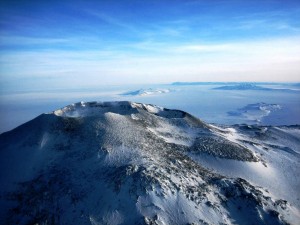
Aerial view of Mt. Erebus crater, the southernmost active volcano in the world. Photo courtesy of Christopher Dean, National Science Foundation.Eric Muller, science educator for the Exploratorium Teacher Institute in San Francisco, CA, provides a hands-on, “feet-on” way of teaching about volcanoes and the layers of the Earth.
Beyond Penguins Podcast Archive
What is a Podcast?
Learn more about podcasts, RSS feeds, and other terms related to multimedia in this article.
Every month, Robert Payo and Stephanie Chasteen will be trekking across the poles to find ways to help you
teach science in your elementary classroom. We tackle common misconceptions your students might have about
science using stories, teaching activities, and the latest news related to the poles.
Here are some suggested ways to use podcasts in your teaching:
- Listen to learn new teaching ideas and build your science content knowledge.
- Have older students listen, write, and discuss episodes or segments of episodes as a way of integrating science and literacy activities.
- Inform your school librarian to include these in your school’s audio collection.
- Share on your classroom web pages for families or with your friends!
This article was written by Robert Payo, and Stephanie Chasteen. For more information, see the Contributors page. Email Kimberly Lightle, Principal Investigator, with any questions about the content of this site.
Copyright December 2008 – The Ohio State University. This material is based upon work supported by the National Science Foundation under Grant No. 0733024. Any opinions, findings, and conclusions or recommendations expressed in this material are those of the author(s) and do not necessarily reflect the views of the National Science Foundation. This work is licensed under an Attribution-ShareAlike 3.0 Unported Creative Commons license

